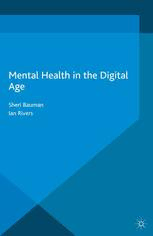
Mental Health in the Digital Age PDF
Preview Mental Health in the Digital Age
Mental Health in the Digital Age AlsobySheriBauman CYBERBULLYING:WhatCounselorsNeedtoKnow SPECIALTOPICSFORTHEHELPINGPROFESSIONALS PREVENTINGADOLESCENTDEPRESSIONANDSUICIDEAMONGLATINAS: ResilienceResearchandTheory(co-author) PRINCIPLESOFCYBERBULLYINGRESEARCH:Definition,Methods,and Measures(co-editor) AlsobyIanRivers BULLYING:ExperiencesandDiscoursesofSexualityandGender(co-editor) LESBIAN,GAY,BISEXUALANDTRANSGENDERAGEING:ProvidingEffective SupportthroughBiographicalPractice(co-editor) OUTOFTHEORDINARY:RepresentationsofLGBTLives(co-editor) HOMOPHOBICBULLYING:ResearchandTheoreticalPerspectives BULLYING:AHandbookforEducatorsandParents(co-author) Mental Health in the Digital Age Sheri Bauman Professor,DepartmentofDisabilityandPsychoeducationalStudies,Universityof Arizona,USA Ian Rivers ProfessorofHumanDevelopment,DepartmentofEducation,BrunelUniversity London,UK ©SheriBaumanandIanRivers2015 Softcover reprint of the hardcover 1st edition 2015 978-1-137-33316-2 Allrightsreserved.Noreproduction,copyortransmissionofthis publicationmaybemadewithoutwrittenpermission. Noportionofthispublicationmaybereproduced,copiedortransmitted savewithwrittenpermissionorinaccordancewiththeprovisionsofthe Copyright,DesignsandPatentsAct1988,orunderthetermsofanylicence permittinglimitedcopyingissuedbytheCopyrightLicensingAgency, SaffronHouse,6–10KirbyStreet,LondonEC1N8TS. Anypersonwhodoesanyunauthorizedactinrelationtothispublication maybeliabletocriminalprosecutionandcivilclaimsfordamages. Theauthorshaveassertedtheirrightstobeidentifiedastheauthorsofthis workinaccordancewiththeCopyright,DesignsandPatentsAct1988. Firstpublished2015by PALGRAVEMACMILLAN PalgraveMacmillanintheUKisanimprintofMacmillanPublishersLimited, registeredinEngland,companynumber785998,ofHoundmills,Basingstoke, HampshireRG216XS. PalgraveMacmillanintheUSisadivisionofStMartin’sPressLLC, 175FifthAvenue,NewYork,NY10010. PalgraveMacmillanistheglobalacademicimprintoftheabovecompanies andhascompaniesandrepresentativesthroughouttheworld. Palgrave®andMacmillan®areregisteredtrademarksintheUnitedStates, theUnitedKingdom,Europeandothercountries. ISBN 978-1-349-56654-9 ISBN 978-1-137-33317-9 (eBook) DOI 10.1057/9781137333179 Thisbookisprintedonpapersuitableforrecyclingandmadefromfully managedandsustainedforestsources.Logging,pulpingandmanufacturing processesareexpectedtoconformtotheenvironmentalregulationsofthe countryoforigin. AcataloguerecordforthisbookisavailablefromtheBritishLibrary. AcatalogrecordforthisbookisavailablefromtheLibraryofCongress. Contents ListofFigures vi AbouttheAuthors vii 1 OverviewofMentalHealthintheDigitalAge 1 2 MentalHealthontheInternet:OpportunityorDanger? 7 3 MentalHealthTreatment 26 4 ResearchandEthicsintheDigitalAge 51 5 RisksandResilienceinCyberspace 65 6 SocialNetworking 79 7 BeingConnected:FriendshipsandSocialInteractions 103 8 VirtualWorlds 117 9 Representing“TheSelf”Online 141 10 Conclusion 156 References 161 Index 176 v Figures 2.1 GroupTherapyintheDigitalAge 14 vi About the Authors SheriBaumanisaprofessoranddirectoroftheCounselinggraduate programattheUniversityofArizona.Priortoearningherdoctorate in 1999, she worked in public schools for 30 years, 18 of those as a school counselor. She is a licensed psychologist (currently inactive). Sheconductsresearchonbullying,cyberbullying,andpeervictimiza- tion,andalsostudiesteacherresponsestobullying.Sheisafrequent presenter on these topics at local, state, national, and international conferences.SheistheauthorofSpecialTopicsforHelpingProfessionals andCyberbullying:WhatCounselorsNeedtoKnow,andisleadeditorof Principles of Cyberbullying Research: Definition, Measures, and Methods. She is the author of over 50 publications in peer-reviewed journals, manybookchapters,threetrainingDVDs,andnumerousotherpub- lications.ShehasbeentherecipientoftwograntsfromtheNational ScienceFoundationandisnowbeginningworkonagrantfromthe NationalInstituteofJusticetoinvestigatehowSchoolResourceOffi- cersimpactschoolclimateandsafety,andtotestthevalueaddedof anenhancedmodelfortrainingschoolresourceofficers. Ian Rivers is a professor within the Department of Education at Brunel University London and holds visiting professorships at the UniversityofStrathclydeandAngliaRuskinUniversity.HeisaHealth Care and Professional Council registered psychologist, and for over 20yearshasbeenanactiveresearcherinthefieldofbullyingbehavior anddiscrimination.HeistheauthorofHomophobicBullying:Research and Theoretical Perspectives, and lead author of Bullying: A Handbook for Educators and Parents. He is a recipient of the British Psychologi- calSociety’sAwardforPromotingEqualityofOpportunityintheUK, and regularly writes for the Times Educational Supplement on school behavior issues. He is a Fellow of the American Psychological Asso- ciation,theBritishPsychologicalSociety,andtheAcademyofSocial Sciences. vii 1 Overview of Mental Health in the Digital Age Mental health is defined by the World Health Organization (WHO) as, “a state of well-being in which an individual can realise his or her own potential, cope with the normal stresses of life, work productively, and make a contribution to the commu- nity” (http://www.euro.who.int/__data/assets/pdf_file/0004/215275/ RC63-Fact-sheet-MNH-Eng.pdf?ua=1, p. 1). This definition is also used by the Centers for Disease Control in the United States (US). Indicators of mental health include perceived life satisfaction, gen- erallypositiveemotions,optimism,purposeinlife,healthyrelation- ships with others, and self-acceptance. Mental health is the optimal psychological state, and attaining that state is a putative goal for people everywhere. It is part of overall health, and is influenced by genetic,biological,andenvironmentalfactors. On the other hand, mental illness is a serious public health problem around the world, with about 450 million people hav- ingamentalhealthdisorder(http://www.mentalhealth.org.uk/help- information/mental-health-statistics/UK-worldwide/). Anxiety and depression are the most common disorders. About 25% of adults in theUSandUnitedKingdom(UK)willexperienceamentalillnessin a given year, while 13% of US youth aged 8–15 and 20% of adoles- cents aged 13–18 will have a severe mental disorder in a given year, alongwith13%ofthoseaged8–15(NAMI,2013,http://www.nami. org/factsheets/mentalillness_factsheet.pdf).In the US, the economic impactofmentalillnessisenormous.Itisestimatedthat$193.2bil- lion in earnings are lost to mental illness each year; in the UK, the Organisation for Economic Co-operation and Development (OECD) 1 2 MentalHealthintheDigitalAge estimatesthatthecostofmentalhealthproblemsisabout£70billion peryear.Inadditiontotheeconomicimpact,thereareothernegative consequences. For example, more than 50% of US students aged 14 and older with mental disorders drop out of school (NAMI). Unfor- tunately,about60%ofadultswithmentalillness,andhalfofyoung peopleaged8–15,donotreceiveservicesfortheircondition(NAMI). IntheWHOEuropeanregion,about25–35%ofthepopulationhasa mentaldisorderinagivenyear,butasintheUS,onlyhalfofpeople withthesedisordersreceivetreatment,andnotallofthattreatment is of good quality. Although rates of mental illness vary depending on the disorders included and the source of data, there is no doubt that these disorders affect significant numbers of people, negatively impacttheirqualityoflife,andinvolvelossestosocietyatlarge. Wenowliveinaworldthatissaturatedbydigitaltechnology.The changes that have come about as a result of this technology have beendescribedas“theIndustrialRevolutionofourtime”(Kaufman, 2012).TheWorldWideWebwasintroducedinthe1990sandbythe endofthatdecadehadbecomepartoflifeforasignificantportionof the population. In the 2000s, computers became faster and smaller, mobile phones were commonplace, and many people in the devel- oped world began to rely on this technology to navigate their daily lives. In the current decade, the 2010s, we have smart phones and tablets and cloud computing, all of which put the Internet at our fingertips. There are those who would draw a connection between the risks inherent in the new technologies and increases in mental health problems,buttoourknowledgesuchaconnectionisnotsupported bydata.Aswithearlierinnovations(telephones,television),thenov- eltyevokesfears,andthemediasometimesinflamesthesefearswith coverage of extreme cases of harmful consequences of technology use.Inreality,therearebothrisksandbenefitstodigitaltechnology, andwebelievethatthebenefitsfaroutweightherisks.Nevertheless, it is important to understand the intersection of mental health and digital technology in order to make informed decisions about the manyoptionsavailableincyberspace. Thequestionsweaddressinthisbookare: 1. Is mental health enhanced or diminished by the digitization of ourworld?
